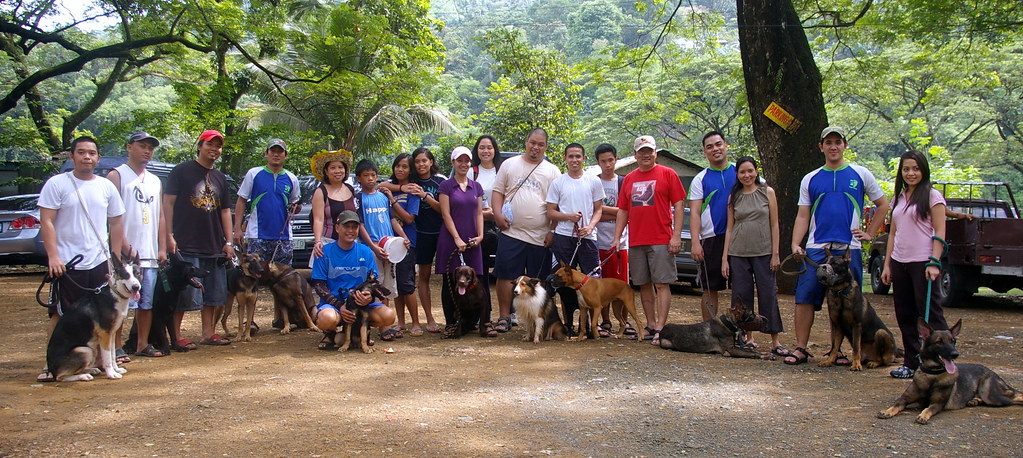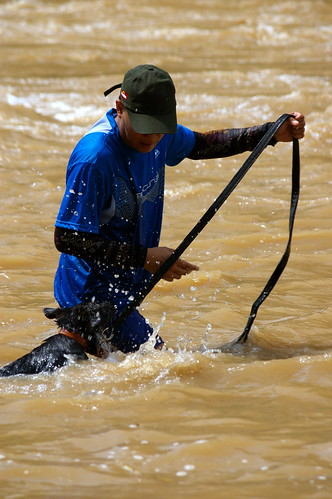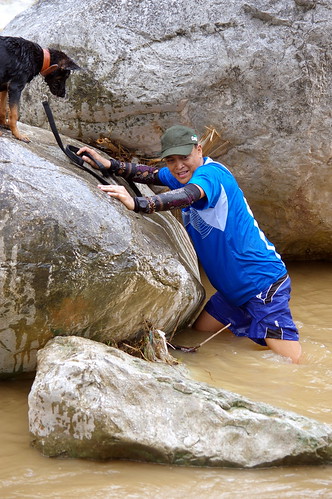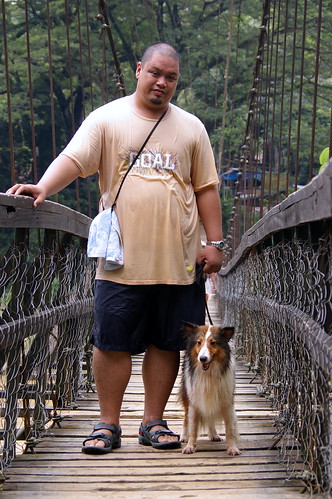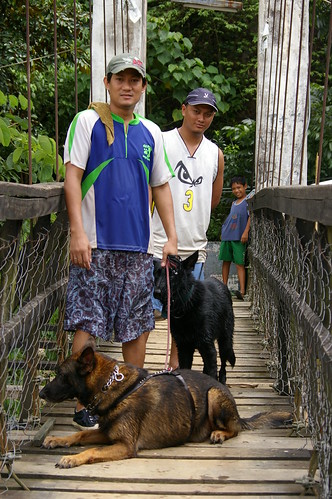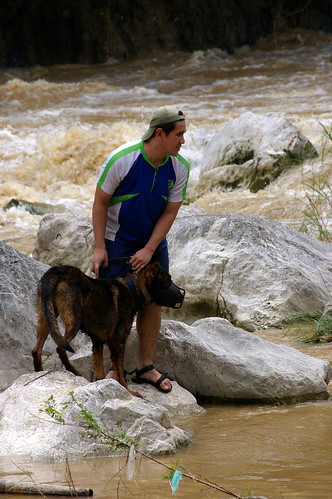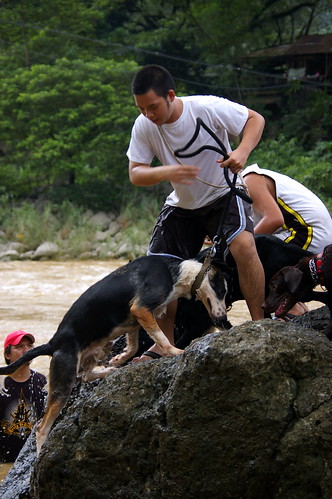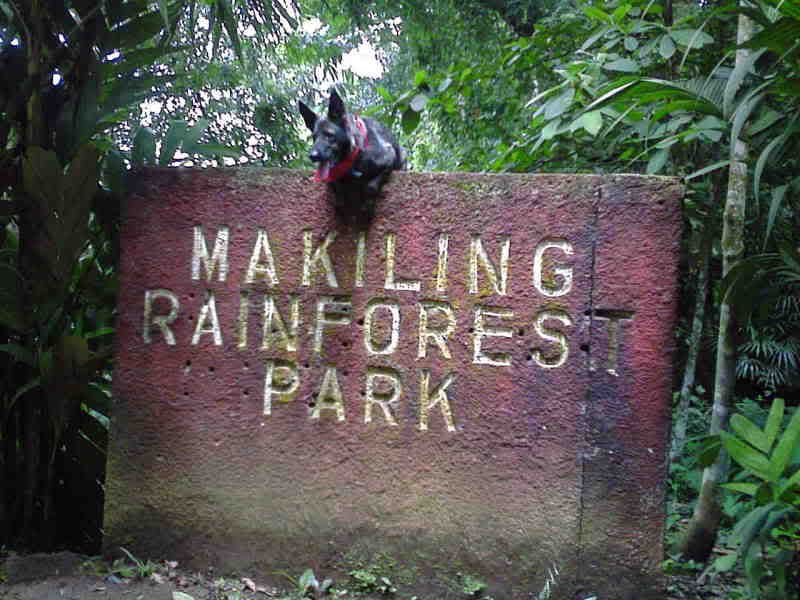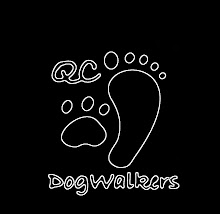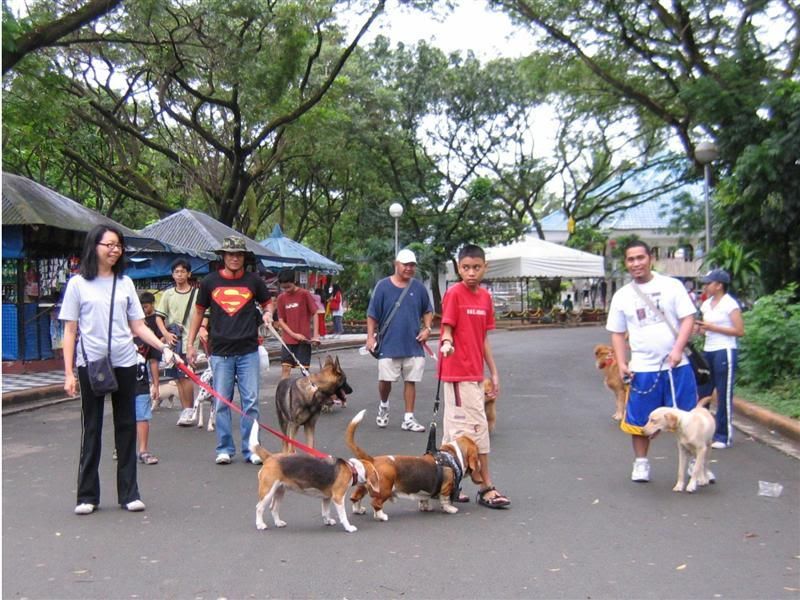SITE STILL UNDER CONSTRUCTION
ABOUT US
Schedule of Activities
Dogwalks
Dog Hikes
Saturday, September 5, 2009
Tuesday, August 25, 2009
Reflection
Looking back at my childhood, I was really very fond of dogs. I enjoy petting them, and playing with them. Our native dogs back then was not so close to my other siblings as I was the only one who was really a dog lover then. During my elementary days, when I arrived home, my dog will always be there waiting for me at our gate. It gave me joy to see my dog excited as I enter our gate.
Watching movies with dogs at that time made me dream of having a Pure breed dog. The dog that I cannot forget was Rin Tin Tin. So that movie struck me the most. I was amazed on how he can do so many things. But since I was a kid at that time, I can only hope and dream, so I promise myself, one day, I will have my dream dog. A German Shepherds Dog. It took me less than two decades to have one. I got a showline GSD a few years back That time I was just starting to learn about having a showline and a working line GSD's. I was so curious that I also got a working line GSD.
Now that I have my GSD's I was curious on dog training. I think this was a turning point for me as a dog lover. I have research several methods and tried it. I was beginning to read about prey drive, calm bite etc. But there was a certain group that caught my attention, and I was very curious to see on how they train their dogs. They were very controversial at that time, but I can see their point on dog training and how practical they train their dogs. I just can't understand the method and approach of what they are saying. So I looked for a way to enter their group, and with the help of someone I was able to do so. First time of training, it was full of stress, there were firecrackers, smoke, other dogs and handlers, and a lot of distractions. My dog went wild, but with their guidance, slowly I was able to control my dog. I was asked to cross the bamboo bridge and to show no hesitation. I also have to cross the body of water without hesitation. So I just did what I was told, I followed without asking because I was there to learn. We did some natural agility combined with obedience. This was very unusual method of dog training. I have read some articles about dog training but this was very different, no treats were given to the dogs after every exercise, yet the dog was not forced to do something. During the break time, I was asked to let my dog do a long down stay, I was surprised to see that he can already do the long down stay, with other dogs and lots of distractions.
I was amazed and at the same time confused. I really can't understand what was going on. My dog did not have any obedience prior to that day. When I came back home, my dog was very different, he can do basic obedience already. That day I know that it was the training that I was looking for. Not because it was fast, but because it was more practical on my daily application. Although the type of training is very different from what can be searched on the Internet. Mostly articles on the web will include training with treats, as a form of reward. Not putting your dog to stressful environment during training will also ease up the training and will not destroy your dogs confidence. Some articles also encourage that dogs that does not know each other should be allowed to sniff one another in order to get acquainted. Probably these are the main difference between the training method I have chosen from the common training methods available on the web. Dogs were not given any rewards except for praise. A “good sit” or a “good come” was enough reward. Yet you can see the expression of the dog being happy to work with its handler.
I do not say that this is a better method than using rewards, but for me if I will remove treats, it will be better if I will start my training without treats. I also find it more practical because stress is inevitable in our daily life. If we can handle our dogs in stressful environment then it would be easier to handle them in a not stressful environment. I also realized that training with distractions does not make a dog fail, but rather make it understand that its part of its daily life, so its normal to have distractions but the dog should still be obedient.
During that time that I was training my first working line GSD, I was not really aware of what I am doing, I am just there to teach my dog basic obedience, and bitework. For me it was just dog training without treats, with applied stress and distractions. And I like the results, at that time that was good enough for me.
For some reason I have to let go of my first Workingline GSD to be able to get a new pup, so I invest on a new pup. I say invest because it involves a lot of money, after purchasing the pup I still have to budget my income for the expenses that I will spend on training, such as gasoline. This time though, I was deeply involve in this method of training, I slowly realize that dog training is not just a matter of having your dog sit, down, or stay. As days goes by, I was exposed to a deeper meaning of dog training. As I was taught that dogs need not to be train for obedience. A dog knows how to sit, it will lay down if it wanted to, it will stay on one place if it wants. Its agility is natural. So its just making them do the things they can, on the time I wanted them and needed them to do. I was not really training my dog, it was merely communicating with her. Through body language, voice, emotion. I was able to communicate with her. It was not just dog training, but it was dog handling. I slowly learn to read my dog, I can tell by her movements on what she wanted to do, on what she is thinking. I can almost anticipate her next move. I was not training my pup or dog, but its the other way around. She is teaching me on how to handle her.
Through this method that I was privileged to learn, I have realized many things about working dogs. It gave me a deeper understanding on my dog and maybe dogs in general. I have known what being a true leader to the dog is all about. As I was exposed on what is natural to the dog, I have learned on how to work with his natural abilities. The good thing about this is that I just did not learn about dog handling, I have also learned many things about myself. Through this it made me a better person. With this type of training, the dog, the handler, and the work is all that matters. If you tend to compete with other dogs and handlers, you will not be successful. You cannot make your dog work exactly as the other dogs in the group because they poses different character, and natural agilities. Some dogs are more agile, some are less agile, the important thing is the dog can perform with in your needs. Another factor is, that with this training you imprint your personality with your dog, therefore other dogs reflect the personality of their handlers as your dog reflects yours.
Dog handling made me a better person because it gave me a different view on dog training and in my life as well. One cannot lie to their dog, therefore we should be honest in dealing with them. As I reflect on the things I lack as a dog handler, I realized that characteristic is also lacking on how I deal with other things as well. That gave me a better view of myself and gave me opportunity on how to change things that I needed to be a better person. To some people this may sound silly, but to those who have done this and is currently doing, I know you understand what I am saying.
I was a dog lover all my life, but for the past years I think I have become more, I become a dog handler. Never did I have shared my life with my dogs the way I am doing it today. I have never built a partnership with any of my previous dogs before, like what I have with my current dogs right now. I say partner because we train together, we work together. It gave me an understanding on what real dogs are. With this, I would like to thank my mentor & all my training buddies, for the guidance. Most of all to my dogs, specially Jersey for teaching me what dog handling is all about.
Posted by
My Dog World
at
Tuesday, August 25, 2009
0
comments
![]()
Thursday, July 30, 2009
The Art of Dog Handling
I am not a professional trainer, nor an expert in handling dogs. But I hope to share some things I learned from my limited experience in handling dogs. I do hope that this would benefit those who are starting to focus on working dog training.
Today most trainers or dog owners train their dog using treats or toys as a reward. This is normal because it is what was handed down to us. The real art of dog handling was almost forgotten. This was handling dogs base on pure handler-dog communication. No props was used but training or handling was done on subtle communication. Through this handler and dog builds the partnership that based on mutual understanding, and mutual trust. Most people promote using treats so that the dog will have a positive outlook on training, or so that the training would be in a happy mood. But lets think deeper, aren't dogs happy just to be with his handler/owner? Even without food, or toys the dog is just happy to be beside us. What else could be more rewarding to them than our sincerest praise. Now people tend to use treats or toys as a tool to communicate with their dog. It is because it is easier to get their attention. People lost interest on how to really get the dogs attention thus the dog focus more on the toys or reward and not on the handler.
Training working dog should be done through partnership. And if you wanted to have a serious dog, one should train seriously. Its that simple. This is hard to explain through words it is better experienced. But for the purpose of example one of the best example I can think of is the military. They used subtle communication most of the time during operation. They communicate through hand signal, eye contact, with minimal use of voice. This only shows that humans are also capable of subtle communication. Another example is a team sport, such as basketball. With spending time of playing with each other, teammates build a chemistry that does not need for words to communicate. Through eye contact and body movements they can anticipate their teammates movement. This is also true in other team sports. And I believe those who have played team sports know what I was talking about. How do they achieve this? Through practice, training, and need. If a teammate did something good, we do not see other teammates giving him a treat, but the sincerity of joy that one feels is felt by the other just by hearing “good job” or “nice shot”, “good defense” etc. This is also true in the military, most of them will get a pat on the back, a recognition from the officer for a good job. Yes there are promotions but it is because we are humans. It is our human nature that we wanted to be recognized
The difference in dog handling is we will communicate to a different creature. So the challenge here is how to make our dogs understand us, and how can we understand them. This is the magic that was almost gone. The most difficult part is starting, because you are still establishing a working relationship with your dog. Most people claims to be a leader of their dog through making them sit before giving their meal, by not making their dog go out of the door before them or by giving them food or toy rewards. But if we think of what a true leader is, a leader should gain ones respect and trust. Being a leader is being a role model, if you want your dog to do something for you, lead your dog and show him the way. Through this you are communicating with the dog what you wanted him to do. And by showing him the way, you slowly gain his respect and trust. The pup's willingness to follow is a great tool for dog training, if we lead him through obstacles without hesitation, the pup will follow without hesitation. Thus because of his willingness to follow, the pup overcome that obstacle, you gain his trust, he gains confidence. For me that is a true sign of being a leader. The leader goes first, and your subordinate will willingly follow. Example you are in a military, who will gain your trust and respect more, a leader who is a type of “attack! follow me” or “attack I will follow”? Think about it.
Funny as this may sound to many, the dog can see if one has a pure intention with dog training. Its with this trait that they give their best abilities if we ask for it with pure intention. Pure intention means you are building working relationship with your dog, not just training your dog. You do this not because you wanted to, but because you needed to. Another thing is that if you train because you wanted your dog to be better than another dog, this will not work, the dog will be able to feel your intention through your actions and attitude. It may seem to be a foolish idea but the dog will prove that this is true. If you give a pup to a child who is looking for a friend or a pet, you will notice this. As the child runs the pup will follow. If it crosses a body of water, the pup will swim. To a child this is not dog training, this is just playing with the pup, this is pure in intention.
Honesty is also a training tool. We should be honest with ourselves and be able to face our weakness, because a dog will only be as good as its handler. If we are not honest with ourselves, we cannot be successful in communicating with them. Because dogs can sense it and we cannot conceal our true self with them. They are honest creatures, they deserve our honesty. With this we also develop our honesty with other people. The dog is a reflection of his handler. Even if we intend to lie, the dog will show its honesty. This is a very nice story I read from a book and I would like to share, a mentor ask his apprentice to teach the dog to detect a bomb. After a week he said to his mentor, the dog is ready. They put it to the test. This is no ordinary test. He was ask to put a blindfold to his mentor and put the article a few feet away from a cliff, he was shocked as he did not expect this kind of test. If the dog fails to stop on the article it could mean the life of his mentor. One of my favorite excerpt from the book, “if we teach with honesty, we too will become honest, if we teach with sincerity, we too will become sincere”.
There are other traits that are essential in dog handling. Fairness; we should be fair in giving correction, and we should not correct the dog for our mistakes. Consistency; we should be consistent with our commands, we should not give a command if we cannot implement it. If we ask the dog to do a long down stay away from us, then the dog breaks, we should go to the dog and correct it no matter how far he is. If not, it will realize that at a certain distance we cannot control him. Another way of being consistent is by giving just one command. If we say “sit” we should let the dog sit on the first command, if we say “sit” the dog did not sit, and repeat our command, he will learn to sit after a couple of commands. Another important factor is believing. We should believe and trust on what the dogs can do. We should be observant on its natural abilities, and work with it.
I hope that this short article will encourage more working dog owners to experience the magic that there is between man and dog. So that they may feel the true essence of what is a true leader and friend to their dog. To end this article I would like to share another excerpt from the same book;
If it is your sincere desire to become a better handler, spend time handling
Posted by
My Dog World
at
Thursday, July 30, 2009
1 comments
![]()
Sunday, July 26, 2009
QCDW and FALKORk9 joins PiPF and MK9 club Makiling HIke
Posted by
DogWalker
at
Sunday, July 26, 2009
0
comments
![]()
Tuesday, July 21, 2009
A Dog Quote
He is your friend, your partner, your dog. You are his life, his love, his leader.
He will be yours, faithful and true, to the last beat of his heart.
You owe it to him to be worthy of such devotion.
I was struck the first time I read this quote. It seems to be full of passion and feelings for the dog. It describe how magnificent dogs are and that they are very loyal creatures and very honest.
Ever since the time I first handle dogs, I never felt the real meaning of friendship and partnership of man-dog relationship until I was introduce with this kind of training method. One will always say our dog is our friend, but its how we treat them as a friend that counts. Its not just providing food, water, & shelter. We should provide them with the physical and mental exercise in order for them to learn and improve their skills. We should not just concentrate on walking them 30 minutes to an hour a day and then we call them friends. When we have friends we spend quality time with them right? That should also be the same with dogs. We should provide the venue and opportunity for the dogs to improve his natural abilities. If we had a friend do we always treat them if we ask a favor from them? May be sometimes, but do you think a real friend will be looking forward for that treat if he does something for you? A real friend would just be happy doing it for you even if there he gets nothing in return. Some or most will argue, isn't it better if you received a reward after doing a favor from a friend? Well may be because that is their attitude towards their friend. Don't you think so?
A partner. There is no better training yet that I know than this method that develops man-dog partnership. In fact it just not develop man-dog partnership but it promotes it. That is why this training is not for everybody. This training is for those who really want to learn how to communicate with their dogs. With this method you will realize what a partner a dog can be. This will also improve your character not just your handling skills. Because this make you know yourself better. To explain briefly on how you develop your partnership with the dog, all training is done with communication. Your dogs will go where you will go. You assist your dog on obstacles that he finds difficult. This might be hard to visualize but once you experience it you will see that there is a magical bond between man and dog. This training will also show that you are his leader. You will lead him through the exercise until he can do it alone. I think there is no better way to earn the respect of your dog than this. If man respects a good leader, what more of a dog. During the hard times of training you are together, so is there a better way to gain a dogs friendship, trust, and respect than this? This will only show that you are his friend, partner and leader.
We as dog lovers sometimes forgot what dogs really are. They are dogs, and they are happy just to be dogs. Now most people will call them babies, treat them as babies. This are the people who claims to be responsible dog owners. If we treat dog as babies they will become weak, and in their natural world there is no room for weakness, as nature will always cull the weak. Today we can see a lot of weak dogs, its because they have been bred for weakness and they are treated to be weak. If only the dogs could speak, they would surely say it is not the right way to treat them.
They are so loyal and honest, that they will not advance when his handler will not. Dogs will go only where handlers will go. Dogs are gift to man, they have a purpose and they were made that way ever since. If we read history, dogs were very useful, they have been used in different purposes. They were given to us to assist us in many works. We owe it to them. It is not our right to have dogs, it was given to us and it is a privilege to have such faithful and honest companion. Unfortunately today, those who treat dogs as dogs are being labeled as irresponsible owners. Because we train them hard and in harsh environments. But little do they know that dogs should be strong, we should treat them strong. It is natural for them to be strong in order to survive. Dogs are noble creatures, and let us treat them the way they should be treated.
Posted by
My Dog World
at
Tuesday, July 21, 2009
0
comments
![]()
Wednesday, June 17, 2009
Foundation
Foundation is very essential to working dogs, this builds their character. While some working dog breeders will opt to finish the vaccines of their pups until given foundation, the true working breeders work the pups as even before the pup has been given a shot. The importance of foundation will show during training and when the pup or dog is put to stress, it will always go back to its foundation.
If the pup is given a wrong foundation or have not been given any foundation there is a low chance that it will be of good character. I never knew this when I started having working dogs. Or even when I started owning dogs. When I brought a pup home I expect that since it is new to the surroundings and environment it is ok that the pup is not at ease or very stressed. I thought it is normal that the pup or dog finds itself in a different environment and will recover in a few days. I believe many people have the same perception with this. They think that it is normal, when in fact the truth is the pup was not given enough foundation or was not
given any at all.
I had my share of this, the first working line GSD I had was not given foundation. I got it at 5 months old, never left the compound of the breeder. Because the compound was big, it was given exercise inside the compound, the pup is set free from time to time to run. First day I got him, he was not very comfortable traveling in a car. Yet I thought its ok its the first time. When I arrived home, I opened the gate, got him out of the car. Unfortunately the collar was a little loose, it got away and went under the jeep of our neighbor. The pup was so scared. Still I think its ok since its the first time. A friend of mine decided to also get a working line GSD, I refer him to the same breeder, he was able to get a pup at the age of 2 months. It was the first time the pup went out of the breeders place. As it seems normal it did not stop crying and was so stressed.
After working with this pup for a couple of months I was fortunate to be able to participate with an exclusive group for a couple of times. There I see there were 4 puppies being given foundation. At the age of 8 weeks they were very comfortable in an environment that is new to them, they didn't mind having big dogs with them. Yet my 6 month old pup was so stressed with the environment. I have seen the difference but at first little did I realize that foundation was the reason behind this.
I worked my first working line for a little less than a year, and decided to sell it so that I can purchase another working line pup from this group. When I contacted the breeder when can I see the pup and choose my pick, he told me we should meet at a place where he is working the pups so I can see for myself what pup would fit me. This is kind of unusual right? Most breeders will invite you home to pick a pup. So we met and I was able to pick my pup. The pup were still 7 months old at that time, and I decided to get the pup at around 8 weeks because I was not experience enough to give the pup the foundation it needed.
A week after, I got the pup at the breeders house, then went straight to Tiendesitas to meet some friends and grab a couple of drink. To my delight the pup just followed us and did not show that it was so stressed or uncomfortable. At first she was a bit hesitant but after a little encouragement she was very comfortable already. We sat at the front near the band where it is very noisy, I just put her in my lap and she did nothing but sleep. I was glad with her reaction, it was very different from my first working line GSD. When we got home she got out of the car, just followed me around the house and never felt uncomfortable. At the bedroom she jump over the bed immediately and looked at me like she wants to play and is very energetic. That time I realize how important foundation is with working dogs. The next day I started working her, we walked around the streets with in our village, and I can see the difference in the confidence of the pup.
A week after I brought it to a friends place, I saw a body of water, I decided to work her there. Once I got into the water she immediately followed. It was a different experience. Another week later I brought her to a river, we introduced her on tracking. I went to the other side of the river while a friend of mine was holding her, then I hid. When she was released, she confidently cross the river and tracks me. So I spend most of the time working her, and until now I continue to work her.
Today it is a common practice not to let the pups out of the kennel until after the pups have completed their vaccines. Some owners also after getting the pup at 8weeks old opts to keep the pup inside their house because it has not completed its vaccines. Little that they realize that they are losing valuable time to give their pups a good foundation. They will start to walk their pups outside at around 4months or older. Most people will accept that their dog is so stressed out because it is the first time for their dogs, when in fact if the pups are given proper foundation it will react differently. Some will even think that its ok to let them out a little late because they will make up for it, unfortunately this will not work for foundation with pups. That window of opportunity have passed. We will not be able to make up for it. I'm not saying pups with no foundation cannot be work, but pups with foundation will definitely show more character during training and during the work itself.
A simple example is during tracking, when a pup was given foundation it will track in any scenario and will focus only on the work. A pup without foundation will track but when faced with unfamiliar obstacle or terrain it will lose its focus.
I wanted to share this experience so that those who are looking for real working dogs will benefit from my lesson. So that they may not commit the same mistake I had before. As I previously said, if one is looking for working dogs, one must go to a working breeder. In my little experience on handling working dogs, the right foundation builds a pups character rather than building its drives. Because when there is a need for serious work, only dogs with character will perform.
Posted by
My Dog World
at
Wednesday, June 17, 2009
0
comments
![]()
Tuesday, June 16, 2009
A properly trained man can be a dogs bestfriend
I have read this phrase but I forgot the author. I believe this to be true. Come to think of it do we really need to train working dogs? If we think deeper, most that we ask our dogs, they can do it naturally. A dog can naturally sit, down, stay, come. Its agility is also natural in them, the dog knows how to jump, balance swim etc. It also has its natural talent, sniffing and tracking. So do we really need to train them? I guess its more appropriate to say that man should be the one who needs to undergo training.
A good example, when we usually arrive home, the dog will naturally come to us, if you stand still in front of the dog long enough you will see that it will voluntarily sit near you. All we need to do is build our communication with our dog. In my opinion it is one of the most important part of man-dog partnership, establishing our communication with our k9 friends. Why do we also teach dogs to track? I believe we are not capable of teaching the dog to track, we are not capable of using our nose to track, what gives us the knowledge to teach the dog to track? As often done in schutzund, they teach the dog foot step tracking by using food. Its either they are fooling themselves or they are fooling others. In a real search the dog should be allowed to use its natural ability to be able to succeed. Usually a dog will do foot step tracking when the track is old, and air scent when the track is fresh. We should allow the dog to use its natural ability where the dog is comfortable. We should only learn to ask then to track for us. If we know how to communicate with them properly, the dog will willingly do it for us.
The more we spend time with them with activities that present challenges to both man and handler, we will see what is natural with them and we will be able to communicate with them with out using any treats or toys. The dog will be able to understand its handler with the tone of his voice, with body language, and emotion, and in return its handler will also be able to read his dogs expression and body language. If both dog and handler will be able to communicate with each other there are a lot of work that can be done.
With this communication we can ask the dog what we want and it will obey us in its own free will even though in the absence of treats. We can simply ask the dog to track for us, and the dog will, it will give us signals that we need to interpret in order for the search to be successful. All work is possible when we are able to communicate with our dog.
The dog will only go as far as where his handler is willing to, therefore we must provide the exercise to be able to develop our dogs. A good dog will show poor if handled by a poor handler, and a bad dog will show to be a good dog if handled by a good handler. So if one want to be a good handler, one should spend time handling his dogs, and learn to communicate with his dog. One must also be sensitive enough to see what is natural with the dog, because one cannot build a communication with the dog if its unnatural with him. The success of communicating with the dog should be base on what is natural with the dog. Therefore we must learn from the dog and not the other way around.
Another factor that also affects our communication with the dog is our intention. The handler must have a good intention to be able to achieve this communication. If the handlers intention is not pure, he will not be able to reach this, why? Because the dog knows and can read our emotion. If the handlers intention on training his dog and making his dog good so that he can show this off, there will be no success. For the dog to follow his handler it should be with pure intention and out of need. This allows the dog to show what is natural in him and will willingly share it with his handler. If not he will deny his handler of this communication.
If we give a pup to a kid, we can see how natural the pup will go with the kid, the pup will follow him and not thinking of getting anything in return. When a pup hesitates to follow, a little encouragement from the kid will make the pup follow. Why does the pup follow? Simply because the kid has pure intentions, the kid has no intention of showing off on what they can do, he simply enjoys the company of the pup.
To be honest it also took me sometime to understand this, the deeper meaning of communicating with the dog. When we do such activities of building communication with our dog, we should not think that we are doing this so that others will see that our dog is good. It should not be done just to have bragging rights. It should not be done so that our dog can be as good as other dogs. It should be done simply because we need our dog to do it. It should be done with the intent of enjoying our journey of life with our dogs as a partner.
Posted by
My Dog World
at
Tuesday, June 16, 2009
0
comments
![]()
Monday, June 15, 2009
My First Lesson
My First Lesson
There was an incident that made me decide, I should get a dog that will be suitable for protection. A suitable choice for me would be a GSD, for ever since I was a kid I was dreaming of having one. I finally got a male working line GSD, the next problem was having him trained. During that time I was observing a local dog forum, there was a group there that was quite controversial, and they where exclusive. Their philosophy about dog training was intriguing as they are more on the practical side of using dogs for real work. Their methods and approach were very different from what is commonly available information on dog training. I had a hard time entering the group, and my first working line GSD needs training ASAP.
I was assisted by a new friend to train my dog, I was excited as I on my way to their place. There I meet his group, most of them have Belgian malinois. My dog was so unstable and I don't know what to do. I was not allowed to use prong, only soft collar. He said using prong collar on my dog at a young age will destroy my dog. Since I was new to working dog training, I followed. Next week I went back to their training group, we did the same routines. I got back home and my dog did not learn anything. I cannot say its the trainer or the method, may be it was because of me.
Suddenly I received a message from one member of the group I was mentioning. I was invited and had the privilege to join their training. Once again my dog went unstable, wanting to bite anybody and any dog near us. I was told to put the prong collar, so I did, my dog became a bit controllable. Then we started training. Their approach is very different, they exposed handlers and dogs to different stressful situations, crossing the river, crossing the bamboo bridge, having some smoke in the path, and with some gun shot simulations. We are doing this as we are teaching obedience to the dog. All this are done without treats or toys, we just simply praise the dog. This was done during the morning. Then we went for a break. Our mentor then asks that the dog be on long down stays. I was shocked, with all the other dogs, chicken and other people around he is asking me to ask my dog to do long down stay, and I have to do this from a distance. He said to me “put your dog on a down stay and come here”. I don't know what to reply, so I said, my dog never did a long down stay before. He replied, “just tell your dog to down, say stay and come here”, so I did tell my dog, down, stay, but as I was walking away from my dog, may be around 3 steps away I looked back at him and I was hesitant that he would follow my command, so right there he stand slowly, I have to put him to down position again. The trainer said, I should not look back and I should learn to trust my dog. He said “TRUST your dog, put him on down stay, then come here and don't look back”. That was exactly what I did, and when I reached my trainer he said, “see your dog can do it, so trust your dog”. He even asked me how come the dog stayed, I cannot answer, so he jokingly said, its magic.
So after some years that has gone by, I can never forget the first lesson I learned, and that is I should Trust my dog. Today as I meet some people interested in working their dogs, I see my self a few years back, they are telling me their dog may not be able to do it. I just smile and answer them, “trust your dog”. Those who do is surprisingly amazed of the outcome as quoted from a true Dogman “It is human mindset that stands in the way of success. Believing is a very strong power, as disbelieving. - Guenther”
Posted by
My Dog World
at
Monday, June 15, 2009
0
comments
![]()
Wednesday, May 20, 2009
Dog Psychology with Mr. Onayd Lumbao
Last Saturday May 17, 2009, our Friend Aino was able to invite dog behaviorist Mr. Onayd Lumbao for a brief talk on basic dog behavior and psychology. After the session we had some dog socials and simple agility.
The session was very practical and enlightening, we hope to invite Mr Lumbao again.
Here are some pics:





Grp picture taking
He recently launched his second book "Nanaginip ba ang mga aso"
Posted by
DogWalker
at
Wednesday, May 20, 2009
0
comments
![]()
Tuesday, March 31, 2009
Vids on biteworks and sendoffs
Dogs Jersey and Grey of Ruben and Joseph are some of Falkor's finest.
With obstacle:
With Gun fire
Posted by
DogWalker
at
Tuesday, March 31, 2009
1 comments
![]()
Falkor Trainings
Recently the QCDW people are so into training.
Here are recent pics while doing different excercises at Falkor K9
Jopes, posing with the real models
Battleground atop at a backhoe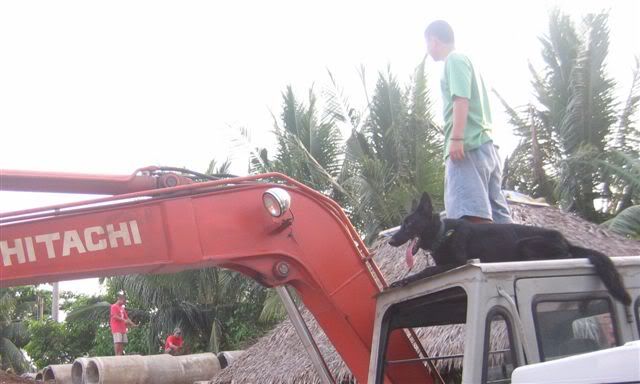
Doc Bong doing some stabilizations w/ dogs Sonja and Vespers
Rubs doin some clinics
Posted by
DogWalker
at
Tuesday, March 31, 2009
1 comments
![]()
